
The long jump is a track and field event in which athletes combine speed, strength and agility in an attempt to leap as far as possible from a takeoff point. Along with the triple jump, the two events that measure jumping for distance as a group are referred to as the "horizontal jumps". This event has a history in the ancient Olympic Games and has been a modern Olympic event for men since the first Olympics in 1896 and for women since 1948.

The triple jump, sometimes referred to as the hop, step and jump or the hop, skip and jump, is a track and field event, similar to long jump. As a group, the two events are referred to as the "horizontal jumps". The competitor runs down the track and performs a hop, a bound and then a jump into the sand pit. The triple jump was inspired by accounts of lengthy jumps at the ancient Olympic Games and has been a modern Olympics event since the Games' inception in 1896.
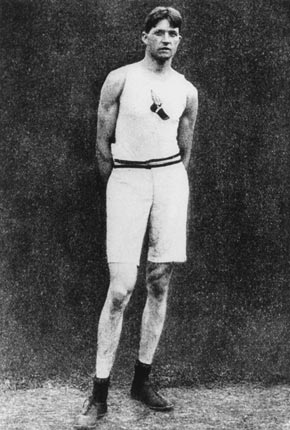
The men's standing triple jump was a track & field athletics event at the 1900 Summer Olympics in Paris, France. It was held on July 16, 1900. 10 athletes from four nations competed in the standing triple jump. The event was won by Ray Ewry of the United States, who took gold in all three of the standing jumps in 1900. His teammate Irving Baxter earned silver in all three 1900 standing jumps. The American sweep was completed with Robert Garrett taking bronze.
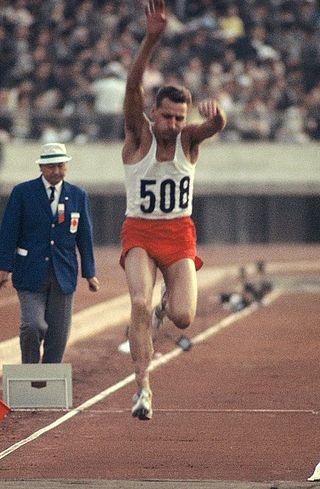
The men's triple jump was one of four men's jumping events on the Athletics at the 1964 Summer Olympics program in Tokyo. It was held on 16 October 1964. 36 athletes from 23 nations entered, with 2 not starting in the qualification round. The maximum number of athletes per nation had been set at 3 since the 1930 Olympic Congress. The event was won by Józef Szmidt of Poland, the third man to repeat as Olympic champion in the triple jump. Just as in 1960, the Soviet Union took silver and bronze behind Szmidt.
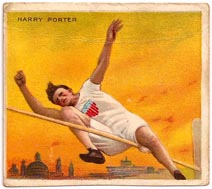
The men's high jump was one of six jumping events on the athletics at the 1908 Summer Olympics programme in London. The competition was held on Tuesday, July 21, 1908. Twenty-two high jumpers from ten nations competed. NOCs could enter up to 12 athletes. The event was won by Harry Porter of the United States, the nation's fourth consecutive victory in the men's high jump. There was a three-way tie for silver.
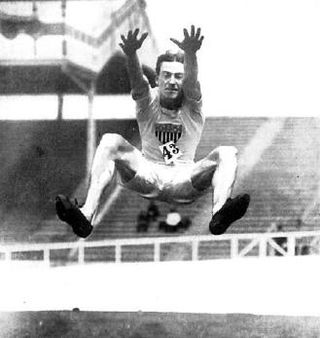
The men's long jump was one of six jumping events on the Athletics at the 1908 Summer Olympics programme in London. The competition was held on July 22, 1908. Thirty-two athletes from 9 nations competed. NOCs could enter up to 12 athletes. The event was won by Frank Irons of the United States, the nation's fourth consecutive victory in the first four Olympic Games. Calvin Bricker of Canada took bronze to break up the Americans' attempt at another sweep.

The men's standing long jump was one of six jumping events on the athletics at the 1908 Summer Olympics programme in London. The competition was held on Monday, July 20, 1908. Twenty-five long jumpers from eleven nations competed. NOCs could enter up to 12 athletes. The event was won by Ray Ewry of the United States, his third consecutive victory in the event. Ewry won all eight standing jump events from 1900 to 1908 as well as both events at the 1906 Intercalated Games. Konstantinos Tsiklitiras of Greece took silver. American Martin Sheridan earned bronze.

The men's long jump was a track and field athletics event held as part of the athletics at the 1912 Summer Olympics programme. The competition was held on Friday, July 12, 1912. Thirty long jumpers from 13 nations competed. NOCs could enter up to 12 athletes. The event was won by Albert Gutterson of the United States, the nation's fifth gold medal in the event in five Games. Calvin Bricker of Canada became the second man to win a second medal in the long jump, adding a silver to his 1908 bronze. Sweden won its first long jump medal with Georg Åberg's bronze.

The men's triple jump, also known as the hop, step, and jump, was a track and field athletics event held as part of the Athletics at the 1912 Summer Olympics programme. The competition was held on Monday, July 15, 1912. Twenty athletes from eight nations competed. NOCs could enter up to 12 athletes. The event was won by Gustaf Lindblom of Sweden, the nation's first medal in the men's triple jump. Georg Åberg and Erik Almlöf also medaled for Sweden, completing a sweep—previously accomplished twice by the United States in 1900 and 1904.

The men's triple jump was an event at the 1956 Summer Olympics in Melbourne, Australia. The event was also known at the time as the hop, step and jump. Thirty-two athletes from 20 nations competed. The maximum number of athletes per nation had been set at 3 since the 1930 Olympic Congress. The event was won by Adhemar da Silva of Brazil, successfully defending his 1952 title. He was the second man to do so, after Myer Prinstein in 1900 and 1904. Vilhjálmur Einarsson won Iceland's first Olympic medal in any event with the silver in this competition. Vitold Kreyer put the Soviet Union on the men's triple jump podium for the second Games in a row with his bronze.
The final of the men's triple jump event at the 1996 Summer Olympics in Atlanta, Georgia was held on July 27, 1996. There were 43 participating athletes from 32 nations, with two qualifying groups. The maximum number of athletes per nation had been set at 3 since the 1930 Olympic Congress. The top twelve and ties, and all those reaching 17.00 metres advanced to the final. The qualification round was held on July 26, 1996. The event was won by Kenny Harrison of the United States, the nation's second consecutive and sixth overall victory in the men's triple jump. Jonathan Edwards's silver was Great Britain's first medal in the event since 1984; Yoelbi Quesada's bronze was Cuba's first men's triple jump medal ever.

The men's triple jump event was part of the track and field athletics programme at the 1920 Summer Olympics. The competition was held from Thursday, August 19, 1920, to Saturday, August 21, 1920. Twenty-one triple jumpers from eight nations competed. No nation had more than four jumpers, suggesting the limit had been reduced from the 12 maximum in force in 1908 and 1912. The event was won by Vilho Tuulos of Finland, the nation's first medal in the triple jump. Sweden, which had swept the medals in 1912, took the next three places. Erik Almlöf became the third man to win two medals in the event, repeating his bronze performance from 1912.
The final of the men's triple jump event at the 1992 Summer Olympics in Barcelona, Spain was held on August 3, 1992. There were 47 participating athletes from 32 nations, with two qualifying groups. The maximum number of athletes per nation had been set at 3 since the 1930 Olympic Congress. Mike Conley Sr. set a new Olympic record with 17.63 m. He also jumped 18.17 m which would also improve the standing world record, but this jump had wind assistance 2.1 m/s. The top twelve and ties, and all those reaching 17.00 metres advanced to the final. The qualification round was held on August 1, 1992. Conley's gold was the United States's fifth victory in the men's triple jump, surpassing the Soviet Union's four. Conley was the 11th man to win two medals in the event, and the first to do so in non-consecutive Games. Frank Rutherford's bronze was the first medal for the Bahamas in the event.

The men's triple jump event at the 1984 Summer Olympics in Los Angeles, California had an entry list of 28 competitors, with two qualifying groups before the final (12) took place on August 4, 1984. The maximum number of athletes per nation had been set at 3 since the 1930 Olympic Congress. The top twelve and ties, and all those reaching 16.60 metres advanced to the final. The event was won by Al Joyner of the United States, the nation's first title in the men's long jump since 1904 and fourth overall. Mike Conley Sr., also an American, took silver. Keith Connor's bronze was Great Britain's first medal in the event since 1908. The Soviet boycott broke that nation's four-Games gold medal and eight-Games podium streaks.
The men's triple jump event at the 1980 Summer Olympics in Moscow, Soviet Union had an entry list of 23 competitors, with two qualifying groups before the final (12) took place on Friday, July 25, 1980. The maximum number of athletes per nation had been set at 3 since the 1930 Olympic Congress. The top twelve and ties, and all those reaching 16.55 metres advanced to the final. The qualification round was held on Thursday, July 24, 1980.
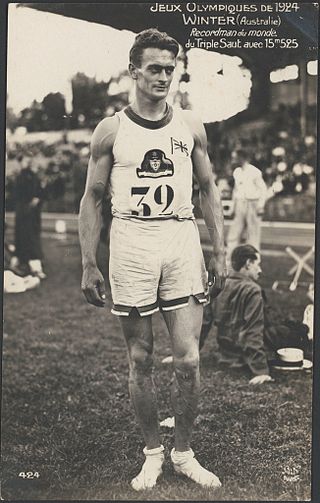
The men's triple jump event was part of the track and field athletics programme at the 1924 Summer Olympics. The competition was held on Saturday, July 12, 1924. Twenty triple jumpers from twelve nations competed. The maximum number of athletes per nation was 4. The event was won by Nick Winter of Australia, the nation winning gold in its debut in the event. Argentina also medaled in its first triple jump appearance, with Luis Brunetto taking silver. Defending champion Vilho Tuulos of Finland took bronze, the fourth man to win a second medal in the event.

The men's long jump event was part of the track and field athletics programme at the 1928 Summer Olympics. The competition was held on Tuesday, July 31, 1928. Forty-one long jumpers from 23 nations competed. The maximum number of athletes per nation was 4. The event was won by Ed Hamm of the United States, the nation's second consecutive and seventh overall victory in the event. Silvio Cator earned Haiti's first medal in the event by taking silver.
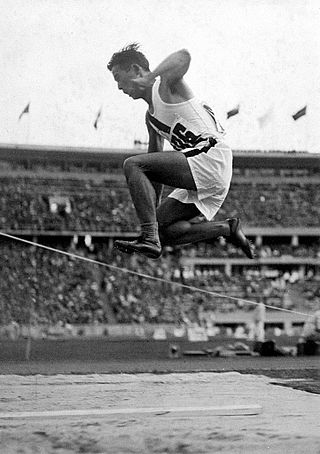
The men's triple jump event was part of the track and field athletics programme at the 1936 Summer Olympics. The competition was held on August 6, 1936. Thirty-one athletes from 19 nations competed. The maximum number of athletes per nation had been set at 3 since the 1930 Olympic Congress. The final was won by Naoto Tajima of Japan with a world-record jump. It was Japan's third consecutive gold medal in the men's triple jump; as of the 2016 Games, it is the last gold medal Japan has won in the event. Masao Harada's silver medal made it the second Games in which Japan put two men on the podium in the event. Jack Metcalfe of Australia earned bronze, Australia's first medal in the event since 1924.

The men's triple jump field event at the 1960 Olympic Games took place on September 6. Thirty-nine athletes from 24 nations competed. The maximum number of athletes per nation had been set at 3 since the 1930 Olympic Congress. Józef Szmidt of Poland won the gold medal. It was Poland's first medal and first victory in the men's triple jump. Vitold Kreyer of the Soviet Union repeated his bronze medal performance from 1956, becoming the sixth man to win two medals in the event. His countryman Vladimir Goryaev took silver; this made the Soviet Union the fourth nation to have two men on the podium in the same year in the triple jump and the fourth nation to reach the podium three Games in a row.

The men's triple jump event at the 1972 Summer Olympics in Munich was held on 3 & 4 of September. Thirty-six athletes from 28 nations competed. The maximum number of athletes per nation had been set at 3 since the 1930 Olympic Congress. The event was won by Viktor Saneyev of the Soviet Union, the fourth man to repeat as Olympic champion in the triple jump. The Soviets were on the podium in the event for the sixth consecutive Games. Jörg Drehmel of East Germany won the first men's triple jump medal by any German jumper. Nelson Prudêncio of Brazil was the ninth man to win a second medal in the event, following up his 1968 silver with bronze in Munich.

















